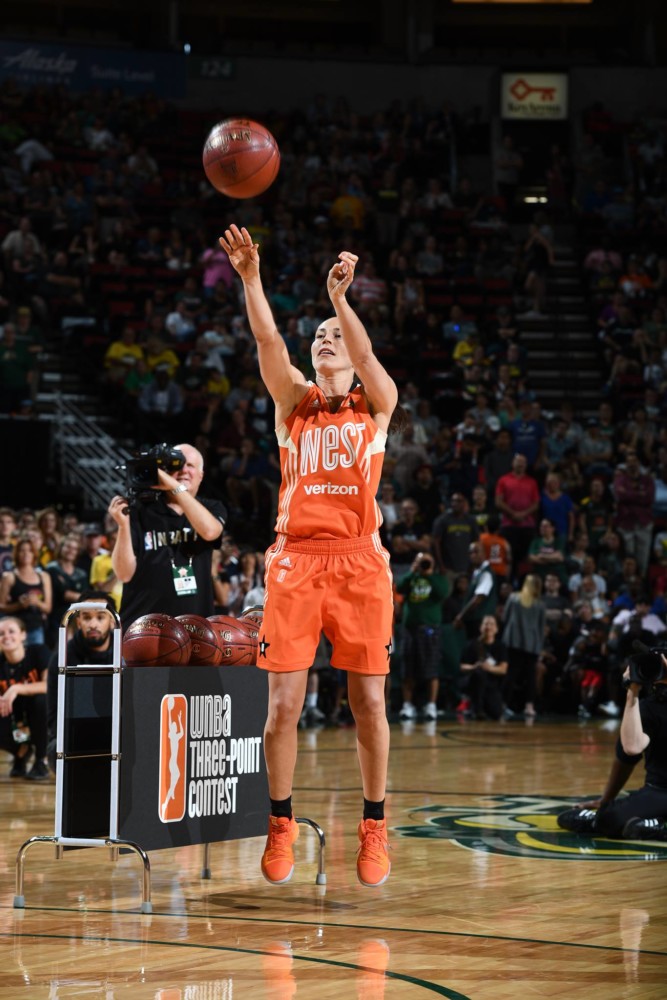By Percy Allen
The Seattle Times
WWR Article Summary (tl;dr) Highlights of the new WNBA-Union agreement include 6-figure salaries and child care benefits.
The Seattle Times
The WNBA and its players union reached a tentative labor agreement on Tuesday that Storm star Sue Bird called “historic” due to its potential to change the financial landscape of women’s professional sports.
“The deal represents moving forward both from a WNBA perspective, but also in general, for women in sports and society,” said Bird, a member of the WNBA Players Association executive committee. “We continue to push forward and there’s a lot of aspects of this deal that mark that.
“When you look at things like what we’re able to do with maternity leave and family planning … We’re going to be looked at as — I think — pioneers in the sports world.”
The WNBA looks to take a leadership role at a time when female athletes have grown disenchanted and vocal about the lack of equity in professional sports.
Momentum has increased significantly for reducing pay and benefit discrepancies, highlighted recently by the U.S. women’s soccer team’s gender-discrimination lawsuit against U.S. Soccer — buoyed by Bird’s partner, Megan Rapinoe.
The eight-year deal, said Storm co-owner Ginny Gilder, represents a progressive business model in which owners and players are equal partners.
“This whole CBA [collective bargaining agreement] is based on a concept of shared risk,” Gilder said. “Everybody gave up something and everybody got something and that’s exactly what both sides wanted. Both sides won.
“We’re betting on ourselves. We’re betting on our ability as a league to bring to our American culture what people say they want. They say they want to support women in sports; well, we are supporting our women athletes in a way that we believe they deserve and we will do everything we can so that the business delivers on that. And so will they.”
The new contract must still be approved by the league’s board of governors. If ratified, it will take effect in May ahead of the 2020 season and be in place through 2027.
Highlights of the new agreement:
–The annual base pay for the league’s highest-paid player rises from $117,500 to $215,000. With other benefits, the league’s top players could earn cash compensation in excess of $500,000.
–The 2020 salary cap rises to $1.3 million, up from $996,100.
–Players receive full salary while on parental leave, an annual child-care stipend of $5,000 and a guarantee of two-bedroom apartments for players with children.
–Enhanced travel standards that include premium economy-class status for all players during regular-season air travel — the league will provide first-class seats for players for the All-Star Game — and individual hotel rooms for every player.
–A minimum of $1.6 million in off-season league and team marketing agreements that recognize top performance and highlight the diversity of the league. Creation of a fund of up to $300,000 in additional annual cash compensation for select players.
–A minimum of $750,000 in prize money for special competitions, including a Commissioners Cup in the 2021 season.
–New 50-50 revenue-sharing beginning with the 2021 season, based on the league achieving revenue growth targets from broadcast agreements, marketing partnerships and licensing deals.
–Increases in cash bonuses with performance awards such as MVP, and new cash bonuses for players earning All-WNBA honors.
The salary increases highlight league Commissioner Cathy Engelbert’s goal: for players to make the WNBA their priority, through incentives that make playing overseas in the off-season less attractive.
Last year, Storm star Breanna Stewart, the 2018 WNBA MVP, tore her Achilles tendon while playing overseas and was forced to miss the 2019 season.
“We’re not precluding players from playing overseas in our off-season, we just want prioritization for the WNBA,” Engelbert said. “As all these tools take effect, and we invest in team and league marketing opportunities and employment, over time we hope our players will play here.”
Bird, the WNBA’s oldest player at 39, wishes similar financial opportunities were available when she began her career in 2002 with the Storm.
“I really view this deal as not just dramatically different, but historic in a lot of ways,” she said. “I’m not throwing shade at anybody, but [for years] the WNBA and the players, we’ve been just going through the motions.
“The best part of this deal is that both sides understood we have a moment. There’s a moment here where our game has gotten better and better and we need to capitalize on that, and this is what it can look like.”
Bird joined the executive committee once the players’ union opted out of the old bargaining agreement in October 2018.
“I was in a unique position given that I’ve been in this league longer than anybody right now,” Bird said. “I know stories of the early days. I’ve lived my own experience and now I’m here and I’ve seen how tides have turned in terms of women and sports.
“I definitely will not be around to reap the benefits [of the new CBA], but what that enabled me to do was have a voice that people can trust because they knew I wasn’t in there advocating for myself. … My only skin in the game is that I want this league to grow and prosper.”
During the last CBA negotiation in 2014, Bird was a player representative for the Storm, but says she was mostly a bystander. Now, she feels her efforts will help future players.
“I talk about it with [the] Storm. I always want to pay it forward with the younger players and make sure they understand what it means to be professional and what it means to wear the Seattle Storm jersey. And in this role it was very similar and I understand it’s all a part of the legacy I can leave.”
___
Distributed by Tribune Content Agency, LLC.














































































































































































































































































































































































